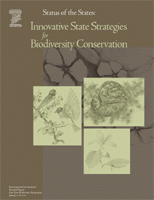
The United States now faces a biodiversity crisis of historic proportions. It is estimated that "one-third of the native U.S. flora and fauna is considered to be of conservation concern." States are currently facing unprecedented habitat loss, degradation, and fragmentation due to sprawl development, agriculture, and other land modifications. Many states are also being confronted with contentious Endangered Species Act battles. However, few, if any, federal laws or programs address protection of the broader array of plants, animals, and ecosystems before they become imperiled. In response, states and state-based groups across the nation have stepped forward to address the issue of biodiversity loss. From California and Oregon, to Florida and Maine, state efforts have sought to develop strategies for addressing the erosion of their natural heritage through the development of comprehensive, collaborative, and proactive strategies for biodiversity conservation and restoration. A state biodiversity initiative typically consists of (1) a strategy for convening multiple interest groups and institutions to achieve consensus on methods to conserve biodiversity; (2) a strategy to identify and assess areas of biodiversity concern for conservation; (3) an effort to review state policy and legal mechanisms that may affect biodiversity; and (4) a strategy for educating the public about biodiversity in the context of the state in which they live.